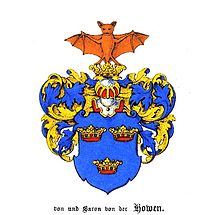Howen (noble family)
Howen or von der Howen (Russian Ховен) is the name of an ancient noble family whose name is traced back to the farm "the Hoeve" in the Dutch province of Geldern near the Westphalian border.
history
In 1394 Lambert van der Hoeven was taken prisoner by the Bishop of Munster as part of the Lords of Bronkhorst during the war between Munster and the city of Deventer . After his release he was mentioned in Borculo in 1397 . The family owned the Wormerdinck fief in the county of Zütphen . In the first half of the 16th century the family is mentioned several times in this area. The spelling of the name changed over time. While van der Hove is used in the oldest documents (1467, 1475, 1485), in the 16th and early 17th centuries the spelling fluctuated between von der Hove (n) , Hof (f) en Huffe (n) , Howe ( n) etc. It was not until about the middle of the 17th century that the expression of Howen was consolidated in signatures .
In Courland , the family line begins with Heyne van der Hove, whom the master of the order Johann von Mengede called Osthoff enfeoffed in Riga with Tetelmünde, an estate in the office and parish of Mitau , and Garrosen, two servants in the office of Bauskenburg. On February 26, 1475 he was given a piece of land by the order master Bernd von der Borch in the area of Mitau on the Auderuppe and on the Würzau, the later Gut Howens-Würzau in the parish of Sessau. Heyne's son Evert was enfeoffed on July 16, 1517 by the order master Wolter von Plettenberg with charity near the Elley and the Audrau. In Courland the family owned until 1843. In the 18th century a line was established that settled in Estonia via Livonia . Eberhard von der Hove was registered in the 1st class of the Courland knighthood on October 17, 1620 . Georg Heinrich von der Howen was registered with the Livonian Knighthood in 1747 and Magnus Gustav von der Howen with the Estonian Knighthood in 1815. The baron title was recognized for the sex by the ukase of the Senate of September 21, 1853.
Family owned goods
The family had, if z. Sometimes only temporarily, both in Courland and Lithuania as well as in Livonia and Estonia over property ownership.
Courland estates
Tetelmünde, Garrosen, Würzau, Wohlfahrt, Audrau, Taymen, Wergruppen and Retztermünde, Bredenfeld, Neu-Würzau, Eckengraf, Marienhof in the parish of Neuchâtel, Brotzen, Neu-Bergfried, Alauen, Weesit and Dannenfeld, the complex Lubben, Lieben, Essern, Tingern , Iwen with secondary estates, Fockenhof and Grenzhof, Suhrs and Stirben, Klein-Drogen, Ostbach and Freiberg.
Lithuanian estate
Imbrady, Owile, Pomusch, Big and Little Plonian.
Livonian estates
Aimel in Fellin County
Estonian estate
Hummala, Pargenthal, Selliküll Kau, Wachmut and Wait.
coat of arms
On a blue shield three golden precious crowns, the edges of which are alternately set with red and blue stones. The crest is a brown bat soaring over the crown.
Significant namesake
- Otto Christopher von der Howen (1699–1775), Courland Court Master, Polish and Electoral Saxon Cabinet Minister
- Otto Hermann von der Howen (1740–1806), chamberlain from the Electorate of Saxony, Oberburggrave from Kurland, Russian privy councilor and senator
- Otto Christopher von der Howen (draftsman) (1774–1848), royal Dutch general of the artillery, painter and draftsman
- Johann August Carl Baron von der Howen (1803–1868), Land Marshal of Courland , Oberburggraf, Chancellor, Landhofmeister and President of the Courland High Court
- Elisabeth Gustava Amalie Sophie Baronesse von der Howen (1834–1923), founder and director of the "Howenschen" girls' school in Reval, which later became the Elisenschule
literature
- Genealogical Handbook of the Baltic Knighthoods (New Series) , Volume 6, Hamburg 2016, pp. 251–289, ISSN 2193-164X
- Genealogical manual of the Courland knighthood , Starke Verlag , Görlitz 1932/33, pp. 308-320
- Genealogical manual of the Estonian knighthood , Starke Verlag, Görlitz 1933, pp. 111–115
-
Genealogical handbook of the nobility , Starke Verlag, Limburg
- Freiherrliche Häuser A , Volume XI, 1979, pp. 118-134
- Adelslexikon , Volume V, 1984, p. 382
- Bastin: Namur et sa province dans l'œuvre du Général de Howen , Crédit Communal de Belgique 1983
- te Rijdt: Een Generaal tekent Nederland , Brussels 1991
Web links
- Lehnsurkunde Würzau 1475 from the Herder Institute Marburg [1]
- Article Howen in "Genealogical Handbook of the Courland Knights", Görlitz 1939 [2]
- Article Howen in "Genealogical Handbook of the Estonian Knighthood", Görlitz 1931 [3]
- Article Howen in the Russian Wikipedia [4]
- Article Howen in Estonian Wikipedia [5]
- Article Howen (Hovens) in the Latvian Wikipedia [6]
